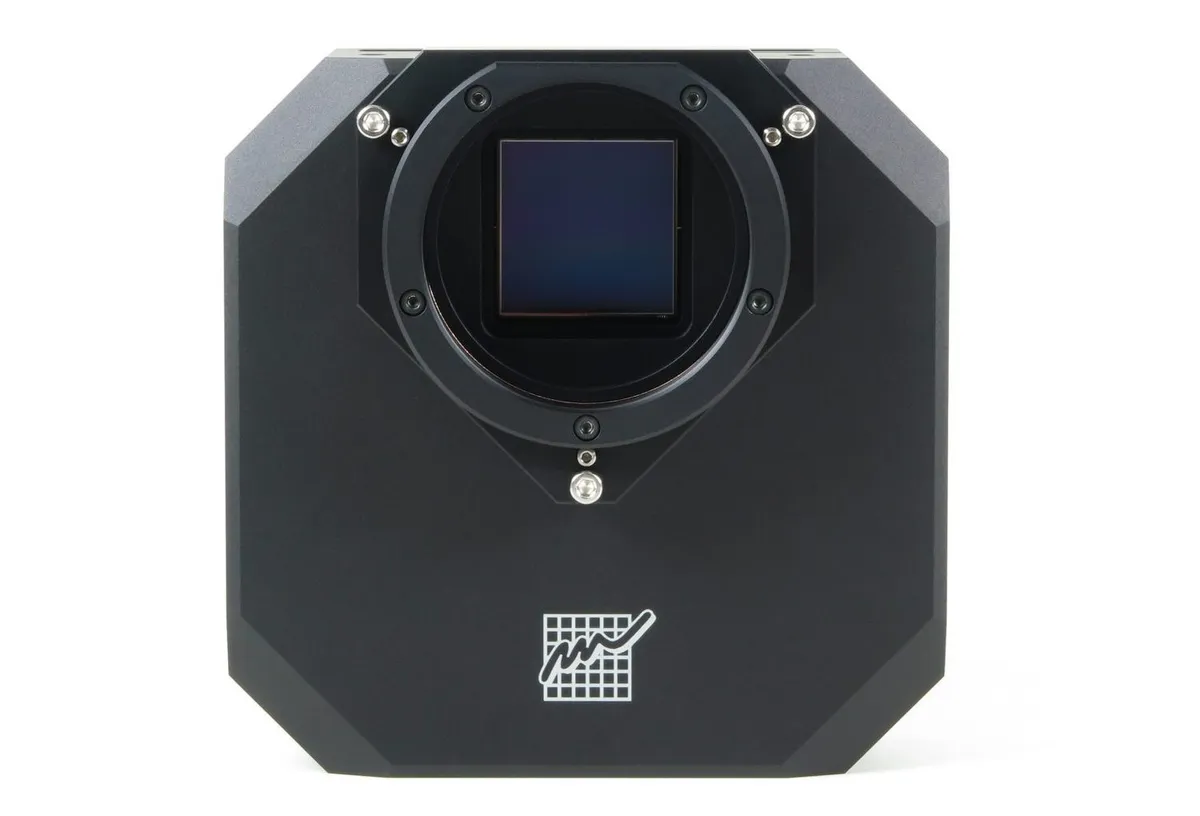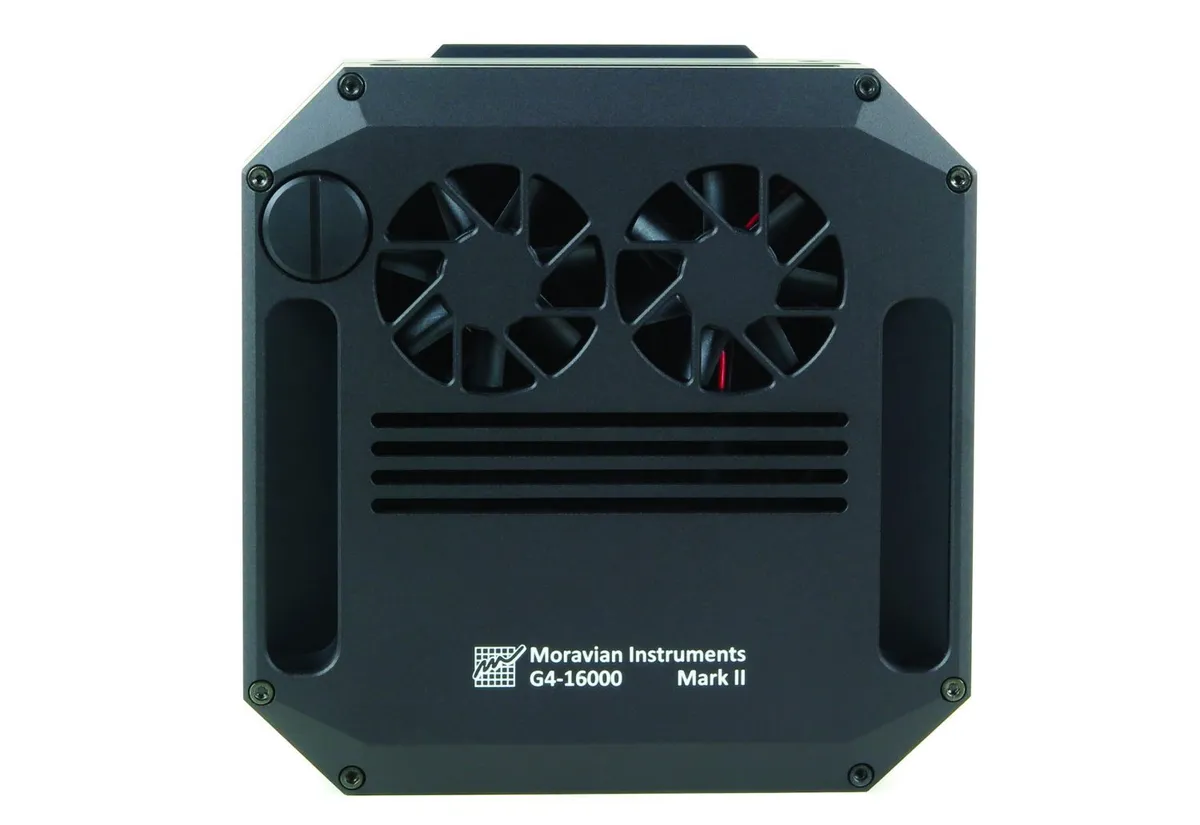The wish-list for astrophotographers who want to capture large objects, or areas of the sky with multiple targets, always includes large format cameras. Moravian Instruments has introduced its G4-16000 MK II full-frame camera that houses the KAF 16803 CCD mono sensor and, looking at the specs, it should tick quite a few boxes on anyone’s list.
The G4-16000 camera model we tested in this review was the EC (enhanced cooling) version.
It came with the Moravian 7 position filter wheel pre-loaded with Baader 50x50mm LRGB and narrowband filters that are all optional extras, but necessary to make the most of the camera.

The G4 16000 is supplied in an aluminium carry case and includes a power supply, USB 2 cable, printed instruction booklets and software and drivers on a USB stick.
It is a camera that is more suited to a permanent setup or observatory and it’s quite a size and weight when mounted with the filter wheel.
The ease of setting up will depend on the telescope setup if using a reducer flattener.
The camera and filter wheel combination come with a M68 thread on the front of the filter wheel and this may take a little working out to get the correct spacing for round stars into the corners of images captured.
We mounted the camera on a 107mm triplet refractor with a 0.75x reducer to attain a good field of view, but were hampered by really poor conditions throughout the review period so we didn’t get a good amount of time to set the correct spacing.
When the sky did finally clear there was quite a bright Moon out, so we had to opt to use the narrowband filters for our imaging purposes.
The software used to take images is Moravian’s own capture software which is called SIPS and it’s capable of a lot more than just the capture side.
The first thing was to set the camera cooling; it can take 15 minutes to cool depending on settings.
As with any software, it’s a good idea to familiarise yourself before the imaging night as there is a lotto get used to.
Focusing is always an issue with large format cameras and can take a bit of time due to the download time of the images from the camera to the computer.

In full capture mode the G4-16000 can take up to 10 seconds to download each frame so we used a focusing mask to speed things up and had an electric focuser that made fine adjustments easier between the filters.
There is a separate installer for the filter wheel that once installed allows you to name each filter, this is then displayed in the capture window for easy rotation of filters.
The first target we chose was the Crescent Nebula as it has a lot of detailed structure in the background.
Setting the camera for five-minute captures in Ha (hydrogen-alpha) there was a lot of stunning detail that appeared on the screen as the images started to download from the G4-16000.
There were a few niggles with the software as it allows you to stretch the image to see any detail that has been captured.
There are some presets for this but each time the next image downloads the software resets this and you have to stretch the image again.
This can also make focusing harder on faint objects or stars. Only having a few hours of darkness, we were out of time for the first session with there being quite a gap before the weather cleared for the next.
This meant capturing an odd 30 minutes here and there on different nights for the next target, but we did manage to get a full set of data on the North American (pictured right) and Pelican Nebula with the narrowband filters.
Once the images were processed we were pleased with the results from the G4-16000 making the efforts worthwhile.
If you have the budget this camera's certainly worth the outlay.

Superior sensor
The G4-16000 camera has a Kodak KAF-16803 sensor housed inside and this has quite a lot to boast about, starting with it being a Class 1.
This means it's free from any column defects.
It has a large 36x36mm imaging area, giving a square resolution: 4,096x4,096 pixels with full well capacity: approximately 100,000 electrons and a pixel size of 9x9 micrometres.
Binning can be independent rows or columns and ranges from 1x1 to 4x4 pixels.
The sensor’s anti-blooming feature stops overexposure on bright stars and objects showing in the adjoining pixels, which helps to keep your images and detail sharper.
Impressive features – including 16 megapixel resolution, low noise and high quantum efficiency, plus an electronic shutter – all help make the camera suitable for scientific applications like astrometry and photometry, as well as narrowband deep-sky imaging.
It can produce some outstanding results with even a short amount of capture time.

Filter wheel
The EFW-4L 7-position filter wheel plugs directly into the camera. This is then programmed and named in the software for the individual filters installed.
Cooling
This G4-16000 model is the EC (enhanced cooling) version that allows for the camera to cool and regulate temperature up to 47°C under ambient temperature. An option in the software to adjust how long the camera takes to cool stops the sensor freezing.
USB connection
The G4-16000 has a built-in high-speed USB 2 connection for hooking up to a computer. This keeps the system stable while downloading large-format images. It makes the option to connect to longer USB leads available without disconnection problems while downloading.
Software
The included software enables full control of the camera and filter wheel. It also has the ability to process and calibrate images that have been captured. Also included are the ASCOM drivers and plug-ins for other popular capture software to make it easy setting the camera up for first use.